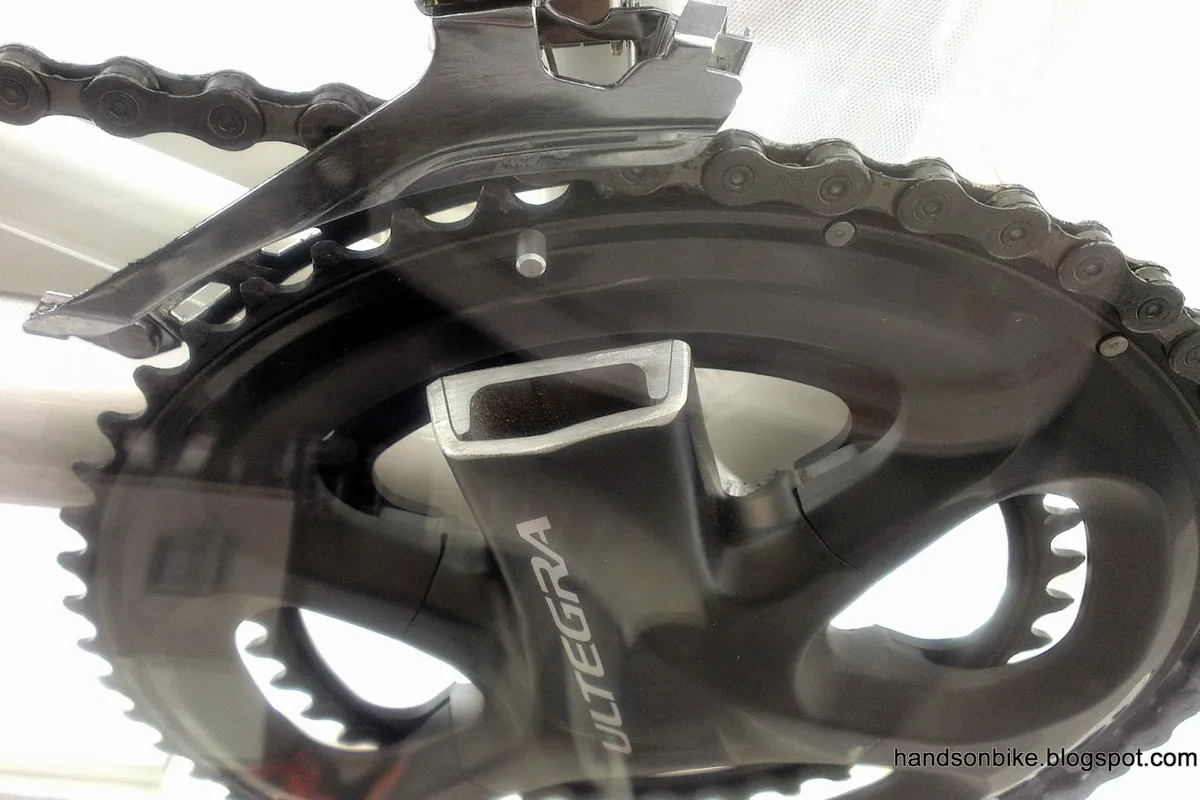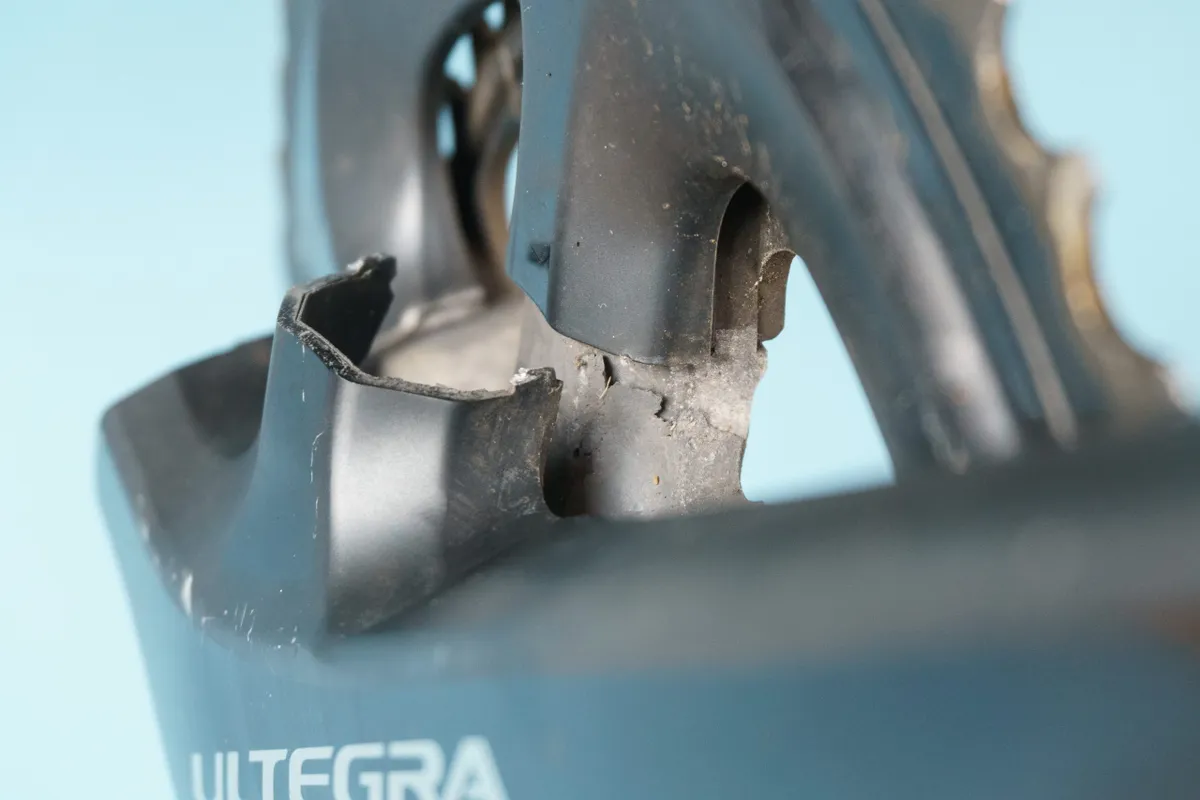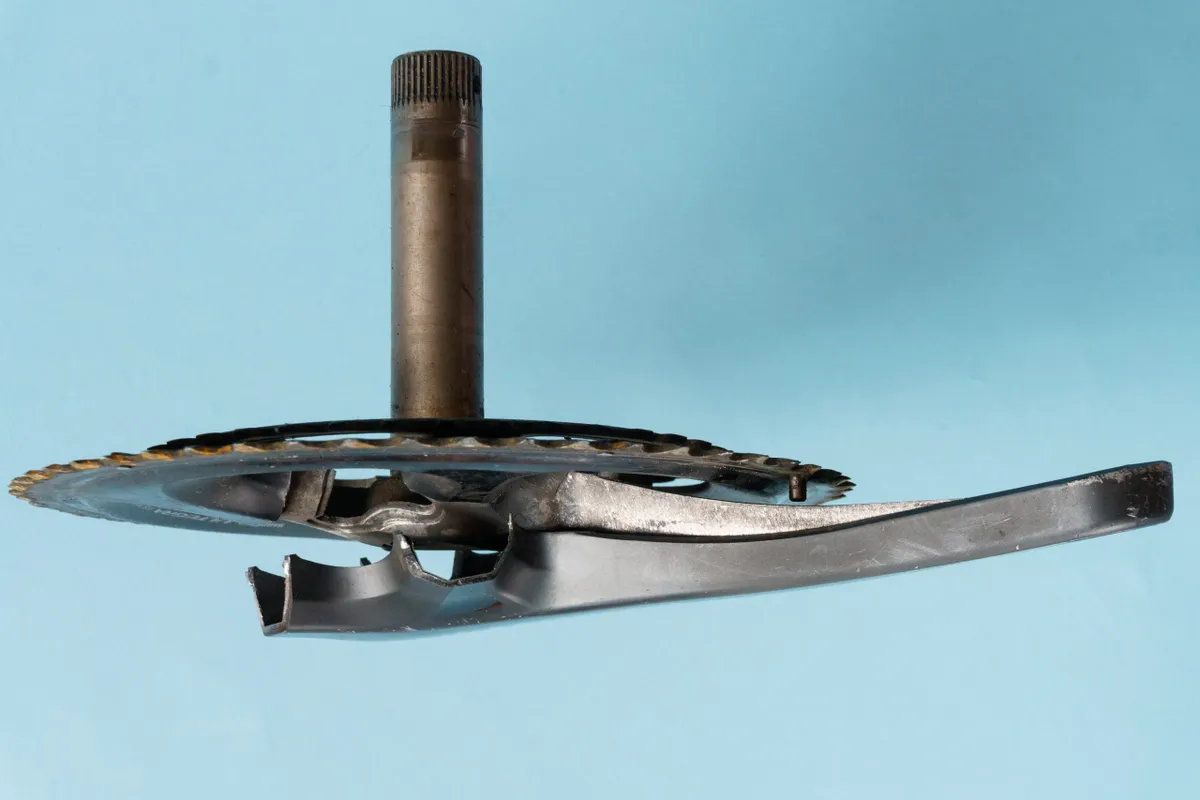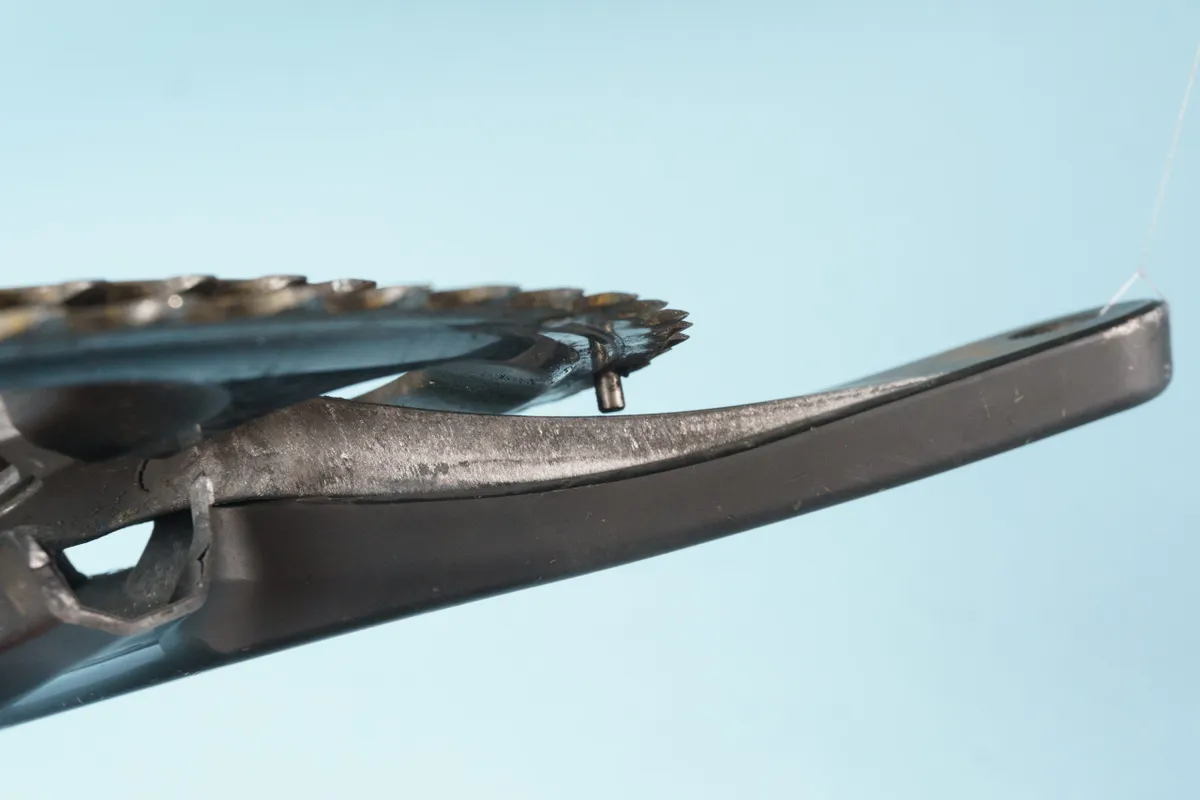Update 21/09/2023: Shimano has issued a recall of Hollowtech road bike cranksets, including the model outlined in this feature. Head to our full story on the recall for further details.
On the morning of 15 January 2020, Stuart Forrest was riding his Pearson road bike to work when its Shimano Ultegra 6800 crankset failed spectacularly.
The outer part of the driveside crank arm separated almost completely from the rest of the crank.
Forrest, a managing director at BikeRadar’s owners Immediate Media, wasn’t injured, but the bike was rendered unrideable.
I wouldn’t normally write a whole article about a single component breaking – it's one crank among countless thousands after all – but the dramatic and seemingly spontaneous nature of this failure bears investigating.
I’ve inspected the broken crank, looked closely into possible causes for the breakage, put questions to Shimano, and explored what reliability really means.
Shimano’s Hollowtech cranks are renowned for their combination of low weight and stiffness, achieved using a unique hollow (hence the name) aluminium alloy construction that’s markedly different to the carbon designs favoured by the competition. Here at BikeRadar, we’d count ourselves as fans of the underlying design.
Hollowtech cranks have been at the heart of some of our favourite groupsets of the last few years, including the likes of Dura-Ace 9000, Dura-Ace R9100, and their more affordable siblings such as Stuart’s Ultegra 6800 groupset, the predecessor to the current R8000 generation that scored a full five stars when we reviewed it in 2017.
It’s more than likely that a new 12-speed Shimano Dura-Ace R9200 groupset will feature Hollowtech cranks too.
Before we continue, I want to be absolutely clear about one thing: we are not in a position to say there’s a problem with Shimano’s Hollowtech cranks, but there is certainly chatter on social media and bike forums around this topic.
On the other hand, while it’s not difficult to find pictures of similarly failed cranks if you go looking, it’s important to consider these in the context of the hundreds of thousands of cranks out in the wild.
Riders who have suffered failures are understandably far more likely to shout about it than those simply getting on with things.
What we do know is that Stuart’s crank failed when it arguably shouldn’t have.
A Shimano Ultegra crank failure as it happened
I asked Stuart to give us some background and describe what happened to his crank. This is what he told me:
“The crank had been fitted to my Pearson Just Killing Time. Checking my emails, it looks like I put it on the bike new in July 2014 when a bike fit recommended going to a 170mm crank.
“Strava tells me I've done 17,000km on that bike, so I reckon that crank has done around 15,000km – I bought the bike from Will at Pearsons earlier that year.
“I'd noticed that it had started to creak quite a lot a couple of weeks before, but the BB needs a service and Ti frames can sometimes exaggerate creaks quite a lot.
“A few days before it had that feeling like the pedal axle had been buckled – you know how the bikes we had as kids which were always left on their sides on the floor and so put buckles into cheap pedal axles? That.
“The day it failed, I was on the commute. Soaking wet day, and I was halfway across the centre of Richmond Park. I went through a corner, and then as I came out and stood up on the pedals, it just collapsed on me. Just a sudden final break which left it as you have it.”
It seems to me that there are two key takeaways from this:
- This crank had done some serious mileage, but nothing we wouldn’t expect a crank to be able to withstand
- It didn’t fail completely without warning, but the warning signs were easy to miss
Analysing the failure
Shimano’s higher end crank arms appear solid on cursory inspection, but they’re actually hollow, hence the name Hollowtech.
Confusingly, Shimano bandies this term around a lot, using it to refer to the bottom bracket standard as well as the style of crank construction.

The arms of Hollowtech cranks like Stuart’s Ultegra 6800s comprise inner and outer aluminium alloy sections with roughly u-shaped cross-sections. The outer section fits over the inner, with the edges overlapping.
I don’t know exactly what process Shimano uses to assemble these, but Shimano has confirmed that the two parts of the crank are bonded together using some sort of adhesive.
There are remnants of a flexible black material between the mating faces of the broken crank, which I believe to be this adhesive.

There are various possible explanations for the failure of Stuart’s crank, here are my best guesses for what might have happened and why.
A design flaw?
Did Shimano under-spec the mating parts of the crank, meaning they’re not up to the job?
Given that the vast majority of Hollowtech cranks don’t fall apart, this seems unlikely. There’s no particular reason to think this construction method is inherently flawed.
Stuart is unlikely to be putting out the power numbers of a WorldTour sprinter, and there are plenty of Shimano cranks in the pro peloton not falling apart.
A manufacturing defect?
There are various ways failure can be built in at the time of manufacturing.
Aluminium alloy parts require careful preparation prior to bonding, typically consisting of abrasion and/or the use of chemicals to remove potential contaminants.
Abrasion increases the effective surface area for the adhesive to stick to, and it removes any oxide layer that may have formed from exposure to the atmosphere.
If this oxide layer isn’t properly removed, it can lead to bond failure down the line, and rather than the adhesive itself letting go, the oxide layer separates from the metal underneath.
Component failures can also stem from components being out of spec. Imagine, for example, if the outer section of a crank were oversized, and the inner portion were undersized, creating a void between the two parts.
If that void weren’t fully filled with the bonding agent, or the agent couldn’t compensate sufficiently for the mismatched parts, it could create a weakness.
A simpler explanation is a lack of sufficient adhesive. It’s very difficult to tell from looking at the failed crank whether there are voids in the adhesive to support this hypothesis, but it is possible.
It's also conceivable that, if a two-part epoxy style adhesive is being used, something is going awry at the mixing stage.
Environmental factors?

Stuart’s crank was used in all weathers, and doubtless exposed to plenty of road salt, meaning some amount of corrosion is likely.
This doesn’t excuse a failure, of course – riding through the winter is not abnormal usage for a crank.
If salty water were able to work its way between the mating sections of the crank it could seriously weaken the bond.
It’s plausible that this is what happened, but it’s not completely clear from examining the cranks if they are actually corroded. If they are, it’s certainly not dramatic.
So how and why did they fail?
This is speculation, but the most likely explanation for the separation of the crank arm seems to be a weakness created by a manufacturing defect, exacerbated by the relatively harsh conditions to which it was subjected.
Looking at the photos, the crank arm appears to be bent inwards, but I’m fairly confident that this happened at the moment of separation, and isn’t the result of an impact.

Without the structural support of the outer section of the arm, the inner section would have been unable to resist the force Stuart was applying to the pedal, causing it to buckle inwards.
The fact that Stuart felt like he had a bent pedal axle in the days before the failure suggests that the cranks had partially separated already, but not enough to compromise their structural integrity fully.
Shimano’s response to reported crank failures
Before we go any further, I should point out that while Stuart’s crank was out of warranty when it broke (Shimano’s warranty covers all parts for two years, apart from top-tier Dura-Ace and XTR level components, which get three years), UK distributor Madison did replace it, and Stuart is still happily using various Shimano components.
I asked Shimano representative Ben Hillsdon if, in the context of Stuart's broken crank and the failures reported elsewhere, the brand is aware of a pattern of failures with its Hollowtech cranks, and here is the official response, reproduced in full:
"We take our customer’s experiences very seriously – one product problem is one too many as far as we are concerned. So we work hard to make sure our products meet our exacting quality standards before they leave our factories, which is evidenced by the millions of riders having countless miles of problem-free experiences.
"It is difficult to answer your question on patterns of failures because there are so many people globally using our products in different circumstances and in different ways.
"For example, one might assume that climatic conditions (eg weather), a rider’s personal riding style (eg power/weight), or usage conditions (eg a crash) could impact product performance but there is no overall pattern that we have identified to explain why one consumer might have an issue whilst a similar consumer will have a lifetime of riding enjoyment.
"We do treat the problem very seriously though. First of all we recommend that consumers regularly maintain their bikes to spot any potential issues.
"Secondly, we are always studying and learning from our current products to make better products in the future, so feedback like this, even though in this case it was an anomaly that was experienced on an older previous generation model, will undoubtedly contribute towards better products for consumers.
"Finally, we recommend that any consumers experiencing any less-than-perfect Shimano product should take it to their nearest dealer to discuss a solution."
Understanding reliability
Reliability is a concept that’s not well understood by the general public. People tend to view reliability as binary – either something is reliable, and won’t break, or it isn’t, and it will.
That’s not how it works, though. Engineers think in terms of design lifespan, and they set targets for how reliably a product must perform to satisfy the needs of its users, balancing that against other factors such as the cost of materials and manufacturing.
A certain number of products will always suffer failures, but this needs to be kept to an acceptable proportion of the total number of units manufactured.
In the case of a crank arm, a hypothetical engineer might hypothetically decide that every rider should expect 30,000km of trouble-free usage.
To achieve this, the engineer might choose to build in a safety margin, say aiming for 40,000km, and set a target that 95 per cent of units should still be functioning at this milestone.
These are completely made-up numbers, but it’s the principle that’s important. If you’re interested in a deeper dive on this subject, I recommend this 2012 article on Wired.
Recalls happen when a product wildly misses its target for reliability, failing in a way that the designers failed to anticipate, or endangers its users.
Shimano’s response above suggests that Stuart’s crank failure would be placed in the arbitrary small percentage of expected failures, the ones that happen seemingly at random and that are taken care of by warranties or the goodwill of bike shops and distributors.
If further failures emerge and Shimano decides that there’s a pattern of unexpected failures that’s the point at which the game changes and a recall might conceivably be issued.
Is there a problem with Shimano cranks?

We’ve only looked at one crank failure in detail here, a single data point in a world awash with Shimano-equipped bicycles. The only things I can state with confidence are as follows:
- Stuart’s crank failed in what you could reasonably describe as normal use
- A non-zero number of other cranks have failed in a manner that is ostensibly similar, but it’s impossible to say how many, and we don’t have data indicating the frequency of failure or details of contributory factors
- The failures reported on social media are not limited to the Ultegra 6800 generation, but there certainly appear to be more Dura-Ace 9000 and Ultegra 6800 cranks represented than Dura-Ace R9100 and Ultegra R8000 ones. This could simply be because the former have been around for longer and are more numerous, of course
- The vast majority of Hollowtech cranks have not failed
What’s BikeRadar’s take? If anything feels off with your drivetrain, you should always investigate it. If you have concerns about a Shimano product, talking to your dealer about them would be a wise move.
We don’t have enough data to say there is or is not a pattern of failures, but if you own a set of Hollowtech cranks, it certainly can’t hurt to check them for signs of separation now and again.


